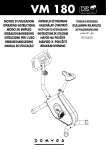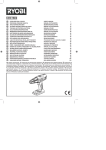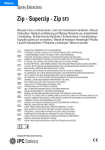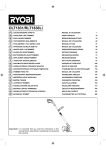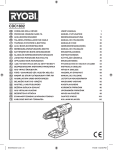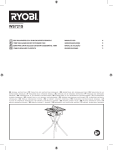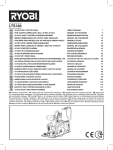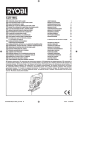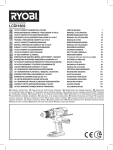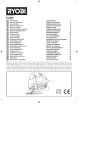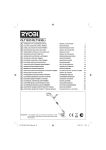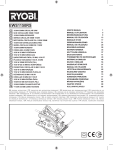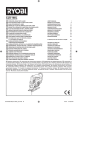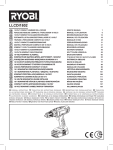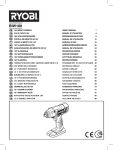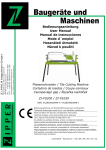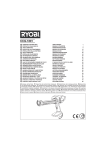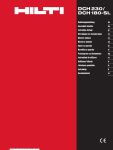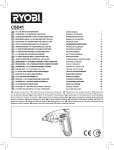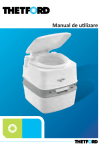Download Ryobi LTS180M Instruction Manual - Tooled
Transcript
LTS180 GB 18 VOLT WET / DRY TILE SAW USER’S MANUAL FR SCIE COUPE-CARRELAGE À EAU / À SEC 18 VOLT MANUEL D’UTILISATION 1 DE ES 18 VOLT NASS / TROCKEN FLIESENSCHNEIDER BEDIENUNGSANLEITUNG 12 6 SIERRA HÚMEDA/SECA DE 18 VOLT PARA AZULEJOS MANUAL DE UTILIZACIÓN 18 IT TAGLIERINA PER PIASTRELLE DA 18V PER TAGLIO UMIDO/A SECCO MANUALE D’USO 24 NL 18 VOLT NATTE / DROGE TEGELZAAGMACHINE GEBRUIKERSHANDLEIDING 30 PT DK SERRA PARA LADRILHO A HÚMIDO / SECO DE 18 VOLTS MANUAL DE UTILIZAÇÃO 36 18 VOLT VÅD/TØR FLISESAV BRUGERVEJLEDNING 42 SE 18 VOLT VÅT-/TORRKAKELKAP INSTRUKTIONSBOK 47 FI 18 VOLTIN MÄRKÄ/KUIVA TIILISAHA KÄYTTÄJÄN KÄSIKIRJA 52 NO 18 VOLT VÅT / TØRR FLISSAG BRUKSANVISNING 57 RU PL CZ ПИЛА ДЛЯ РЕЗАНИЯ ПЛИТКИ (СУХОГО И СО СМАЧИВАНИЕМ), 18 В êìäéÇéÑëíÇé èé ùäëèãìÄíÄñàà 62 18V AKUMULATOROWA PIŁA DO CIĘCIA PŁYTEK (NA SUCHO I MOKRO) INSTRUKCJA OBSŁUGI 68 18 VOLTOVÁ PILA PRO SUCHÉ/MOKRÉ ŘEZÁNÍ DLAŽDIC NÁVOD K OBSLUZE 74 HU 18 VOLTOS SZÁRAZ/NEDVES CSEMPEVÁGÓ HASZNÁLATI ÚTMUTATÓ 79 RO LV MAŞINĂ DE TĂIAT CU DISC DIAMANTAT UMED / USCAT DE 18 VOLŢI MANUAL DE UTILIZARE 84 18 V MITRU/SAUSU FLĪŽU ZĀĢIS LIETOTĀJA ROKASGRĀMATA 89 LT 18 VOLTŲ PLYTELIŲ PJOVIMO STAKLĖS PJOVIMUI SAUSU / ŠLAPIU BŪDU NAUDOJIMO VADOVAS 94 EE HR PLAADI MÄRG / KUIVSAAG 18 VOLTI KASUTAJAJUHEND MOKRO/SUHA PILA ZA PLOČICE OD 18 VOLTI KORISNI»KI PRIRU»NIK 99 104 SI SK GR 18-VOLTNI MOKRA / SUHA ŽAGA ZA PLOŠČICE UPORABNIŠKI PRIROČNIK 109 18 V PÍLKA NA DLAŽDICE PRE MOKRÉ / SUCHÉ REZANIE NÁVOD NA POUŽITIE 114 ΚΟΠΤΗΣ ΥΓΡΩΝ / ΣΤΕΓΝΩΝ ΠΛΑΚΑΚΙΩΝ 18 VOLT ΟΔΗΓΙΕΣ ΧΡΗΣΗΣ 119 TR 18 VOLT ISLAK / KURU FAYANS TESTERESİ KULLANiM KILAVUZU 125 ORIGINAL INSTRUCTIONS FR TRADUCTION DES INSTRUCTIONS ORIGINALES DE ÜBERSETZUNG DER ORIGINALANLEITUNG ES TRADUCCIÓN DE LAS INSTRUCCIONES ORIGINALES IT TRADUZIONE DELLE ISTRUZIONI ORIGINALI NL VERTALING VAN DE ORIGINELE INSTRUCTIES PT TRADUÇÃO DAS INSTRUÇÕES ORIGINAIS DK OVERSÆTTELSE AF DE ORIGINALE INSTRUKTIONER SE ÖVERSÄTTNING AV DE URSPRUNGLIGA INSTRUKTIONERNA FI ALKUPERÄISTEN OHJEIDEN SUOMENNOS NO OVERSETTELSE AV DE ORIGINALE INSTRUKSJONENE RU ПЕРЕВОД ОРИГИНАЛЬНЫХ ИНСТРУКЦИЙ PL TŁUMACZENIE INSTRUKCJI ORYGINALNEJ CZ PŘEKLAD ORIGINÁLNÍCH POKYNŮ HU AZ EREDETI ÚTMUTATÓ FORDÍTÁSA RO TRADUCEREA INSTRUCŢIUNILOR ORIGINALE LV TULKOTS NO ORIĢINĀLĀS INSTRUKCIJAS LT ORIGINALIŲ INSTRUKCIJŲ VERTIMAS EE ORIGINAALJUHENDI TÕLGE HR PRIJEVOD ORIGINALNIH UPUTA SI PREVOD ORIGINALNIH NAVODIL SK PREKLAD POKYNOV V ORIGINÁLI GR μΕΤΑΦΡΑΣΗ ΤΩΝ ΠΡΩΤΟΤΥΠΩΝ ΟΔΗΓΙΩΝ TR ORIJINAL TALIMATLARIN TERCÜMESI GB 10 1 14 10 2 9 3 9 8 4 5 7 6 8 Fig. 2 2 13 16 15 17 18 12 11 Fig. 1 Fig. 3 14 1 13 Fig. 4 Fig. 5 1 19 Fig. 6 Fig. 8 20 11 7 Fig. 7 Fig. 9 Important! It is essential that you read the instructions in this manual before operating this machine. Attention ! Il est indispensable que vous lisiez les instructions contenues dans ce manuel avant la mise en service de l’appareil. Achtung! Bitte lesen Sie unbedingt vor Inbetriebnahme die Hinweise dieser Bedienungsanleitung. ¡Atención! Es imprescindible que lea las instrucciones de este manual antes de la puesta en servicio. Attenzione! Prima di procedere alla messa in funzione, è indispensabile leggere attentamente le istruzioni contenute nel manuale. Let op ! Het is van essentieel belang dat u de instructies in deze gebruiksaanwijzing leest vooraleer u dit toestel in gebruik neemt. Atenção! É indispensável que leia as instruções deste manual antes de utilizar a máquina. OBS! Denne brugsanvisning skal læses igennem inden ibrugtagning. Observera! Det är nödvändigt att läsa instruktionerna i denna bruksanvisning innan användning. Huomio! On ehdottoman välttämätöntä lukea tässä käyttöohjeessa annetut ohjeet ennen käyttöönottoa. Advarsel! Det er meget viktig at du leser denne brukerveiledningen før du tar maskinen i bruk. ÇÌËχÌËe! èee‰ Ò·ÓÍÓÈ Ë Á‡ÔÛÒÍÓÏ ËÌÒÚÛÏeÌÚ‡ ÌeÓ·ıÓ‰ËÏÓ ÔÓ˜eÒÚ¸ ËÌÒÚÛ͈ËË ËÁ ̇ÒÚÓfl˘e„Ó ÛÍÓ‚Ó‰ÒÚ‚‡. Uwaga! Przed przystąpieniem do użytkowania tego urządzenia, należy koniecznie zapoznać się z zaleceniami zawartymi w niniejszym podręczniku. Důležité upozornění! Nepoužívejte tento přístroj dříve, než si přečtete pokyny uvedené v tomto návodu. Figyelem! Feltétlenül fontos, hogy a jelen használati útmutatóban foglalt előírásokat az üzembe helyezés előtt elolvassa! Atenţie! Este esenţial să citiţi instrucţiunile din acest manual înainte de operarea acestui aparat. Uzmanību! Svarīgi, lai jūs pirms mašīnas darbināšanas izlasītu instrukcijas šajā rokasgrāmatā. Dėmesio! Prieš pradėdami eksploatuoti šį prietaisą, svarbu, kad perskaitytumėte šiose instrukcijose pateiktus nurodymus. Tähtis! Enne trelli kasutama hakkamist tuleb käesolevas juhendis esitatud juhised kindlasti läbi lugeda. Upozorenje! Neophodno je da pročitate ove upute prije uporabe ovog uređaja. Pomembno! Pred uporabo tega stroja, obvezno preberite navodila iz tega priročnika. Dôležité! Pre prácou s týmto zariadením je dôležité, by ste si prečítali pokyny v tomto návode. Προσοχή! Είναι απαραίτητο να διαβάσετε τις συστάσεις των οδηγιών αυτών πριν και τη θέση σε λειτουργία. Dikkat! Cihazın çalıştırılmasından önce bu kılavuzda bulunan talimatları okumanız zorunludur. Subject to technical modifications / Sous réserve de modifications techniques /Technische Änderungen vorbehalten / Sujeto a modificaciones técnicas / Con riserva di eventuali modifiche tecniche /Technische wijzigingen voorbehouden / Com reserva de modificações técnicas / Med forbehold for tekniske ændringer / Med förbehåll för tekniska ändringar / Tekniset muutokset varataan / Med forbehold om tekniske endringer / åÓ„ÛÚ ·˚Ú¸ ‚ÌeÒeÌ˚ ÚeıÌ˘eÒÍËe ËÁÏeÌeÌËfl / Z zastrzeżeniem modyfikacji technicznych / Změny technických údajů vyhrazeny / A műszaki módosítás jogát fenntartjuk / Sub rezerva modificaţiilor tehnice / Paturam tiesības mainīt tehniskos raksturlielumus / Pasiliekant teisę daryti techninius pakeitimus / Tehnilised muudatused võimalikud /Podloæno tehniËkim promjenama /Tehnične spremembe dopuščene/ Technické zmeny vyhradené / Υπό την επιφύλαξη τεχνικών τροποποιήσεων / Teknik değişiklik hakkı saklıdır 961067241-01_EU.indd A3 6/24/09 3:27:23 PM :23 PM GB FR DE ES IT NL PT DK SE FI NO RU PL CZ HU RO LV LT EE HR SI SK GR TR English not in line with the blade. Kickback could cause the saw to jump backwards, but kickback forces can be controlled by the operator, if proper precautions are taken. SPECIFIC SAFETY RULES DANGER! Keep hands away from cutting area and the blade. Keep your second hand on auxiliary handle, or motor housing. If both hands are holding the saw, they cannot be cut by the blade. When blade is binding, or when interrupting a cut for any reason, release the trigger and hold the saw motionless in the material until the blade comes to a complete stop. Never attempt to remove the saw from the work or pull the saw backward while the blade is in motion or kickback may occur. Investigate and take corrective actions to eliminate the cause of blade binding. Do not reach underneath the workpiece. The guard cannot protect you from the blade below the workpiece. Adjust the cutting depth to the thickness of the workpiece. Less than a full tooth of the blade teeth should be visible below the workpiece. When restarting a saw in the workpiece, centre the saw blade in the kerf and check that saw teeth are not engaged into the material. If saw blade is binding, it may walk up or kickback from the workpiece as the saw is restarted. Never hold piece being cut in your hands or across your leg. Secure the workpiece to a stable platform. It is important to support the work properly to minimize body exposure, blade binding, or loss of control. Hold power tool by insulated gripping surfaces when performing an operation where the cutting tool may contact hidden wiring or its own cord. Contact with a "live" wire will also make exposed metal parts of the power tool "live" and shock the operator. Support large panels to minimize the risk of blade pinching and kickback. Large panels tend to sag under their own weight. Supports must be placed under the panel on both sides, near the line of cut and near the edge of the panel. When ripping always use a rip fence or straight edge guide. This improves the accuracy of cut and reduces the chance of blade binding. Do not use dull or damaged blades. Unsharpened or improperly set blades produce narrow kerf causing excessive friction, blade binding and kickback. Always use blades with correct size and shape (diamond versus round) of arbour holes. Blades that do not match the mounting hardware of the saw will run eccentrically, causing loss of control. Blade depth and bevel adjusting locking levers must be tight and secure before making cut. If blade adjustment shifts while cutting, it may cause binding and kickback. Never use damaged or incorrect blade washers or bolts. The blade washers and bolt were specially designed for your saw, for optimum performance and safety of operation. Use extra caution when making a "plunge cut" into existing walls or other blind areas. The protruding blade may cut objects that can cause kickback. Check lower guard for proper closing before each use. Do not operate the saw if lower guard does not move freely and close instantly. Never clamp or tie the lower guard into the open position. If saw is accidentally dropped, lower guard may be bent. Raise the lower guard with the retracting handle and make sure it moves freely and does not touch the blade or any other part, in all angles and depths of cut. Causes and operator prevention of kickback: • kickback is a sudden reaction to a pinched, bound or misaligned saw blade, causing an uncontrolled saw to lift up and out of the workpiece toward the operator; • when the blade is pinched or bound tightly by the kerf closing down, the blade stalls and the motor reaction drives the unit rapidly back toward the operator; C heck the operation of the lower guard spring. If the guard and the spring are not operating properly, they must be serviced before use. Lower guard may operate sluggishly due to damaged parts, gummy deposits, or a build-up of debris. • If the blade becomes twisted or misaligned in the cut, the teeth at the back edge of the blade can dig into the top surface of the wood causing the blade to climb out of the kerf and jump back toward the operator. Lower guard should be retracted manually only for special cuts such as "plunge cuts" and "compound cuts." Raise lower guard by retracting handle and as soon as blade enters the material, the lower guard must be released. For all other sawing, the lower guard should operate automatically. Kickback is the result of saw misuse and/or incorrect operating procedures or conditions and can be avoided by taking proper precautions as given below. Maintain a firm grip with both hands on the saw and position your arms to resist kickback forces. Position your body to either side of the blade, but 1 GB FR DE ES IT NL PT DK SE FI NO RU PL CZ HU RO LV LT EE HR SI SK GR TR English SPECIFIC SAFETY RULES CAUTION Water bottle is designed for water only. Use of any other fluid may cause damage to the tool. Always observe that the lower guard is covering the blade before placing saw down on bench or floor. An unprotected, coasting blade will cause the saw to walk backwards, cutting whatever is in its path. Be aware of the time it takes for the blade to stop after switch is released. WARNING A 101.6 mm wheel is the maximum wheel capacity of the saw. Also, never use a wheel that is too thick to allow outer wheel washer to engage with the flat on the spindle. Larger wheels will come in contact with the wheel guards, while thicker wheels will prevent wheel screw from securing wheel on spindle. Either of these situations could result in a serious accident. DESCRIPTION 1. Lock-off button 2. Spindle lock 3. Bevel scale 4. Bevel lock knob 5. Edge guide lock knob 6. Cutting wheel 7. Base 8. Flow adjustment knob 9. Water bottle release button 10. Water bottle 11. Depth lock knob 12. Wheel wrench storage 13. Battery pack (not included) 14. Switch trigger 15. Inner wheel washer 16. Wheel 17. Outer wheel washer 18. Wheel screw 19. Incorrect method of support 20. Correct method of support WARNING Do not use cutting wheels rated less than the no load speed of this tool. Failure to heed this warning could result in personal injury. Do not use wheel with cracks, gaps, or teeth. WARNING Do not use toothed or segmented wheels. Use only continuous rimmed diamond wheels suited for masonry materials. INSTALLING CUTTING WHEEL See Figure 3. Remove the battery pack from the saw. Remove the wheel wrench (5 mm hex key) from the storage area. Depress the spindle lock button and remove the wheel screw and outer wheel washer. NOTE: Turn the wheel screw clockwise to remove. ASSEMBLY ATTACHING GRAVITY FEED WATER BOTTLE See Figure 2. The gravity feed water bottle has a built in air vent that equalizes pressure and allows water to flow more freely. Remove the battery. Unscrew the nozzle assembly. Fill water bottle to desired level. Do not overfill. Replace nozzle assembly. Hold water bottle so that nozzle faces down. NOTE: Water will not escape the bottle unless the tip of the nozzle is depressed. Insert the water bottle as shown. Gently press down on the bottle until it clicks into place. To remove water bottle, depress the water bottle release button. NOTE: For dry cutting, leave water bottle installed to prevent dust and debris from clogging the water supply system. CAUTION To prevent damage to the spindle or spindle lock, always allow motor to come to a complete stop before engaging spindle lock. NOTE: Do not run the saw with spindle lock engaged. Wipe a drop of oil onto the inner wheel washer and outer wheel washer where they contact the wheel. WARNING If inner wheel washer has been removed, replace it before placing cutting wheel on spindle. Failure to do so could cause an accident since wheel will not tighten properly. Replace the outer wheel washer. 2 GB FR DE ES IT NL PT DK SE FI NO RU PL CZ HU RO LV LT EE HR SI SK GR TR English ASSEMBLY WARNING Do not use any attachments or accessories not recommended by the manufacturer of this product. The use of attachments or accessories not recommended can result in serious personal injury. Depress the spindle lock button, then replace the wheel screw. Tighten the wheel screw securely by turning it counterclockwise. Return the wheel wrench to the storage area. NOTE: Never use a cutting wheel that is too thick to allow the outer wheel washer to engage with the flats on the spindle. APPLICATIONS You may use this product for the purposes listed below: Wet cross cutting, rip cutting, and bevel cutting of man-made tile, pavers, and natural stone tile materials. For dry cutting of the above materials, a special cutting wheel is required (not provided). SPECIFICATIONS Voltage Wheel Diameter Wheel Arbor Cutting Depth at 0º Cutting Depth at 45º No Load Speed Wheel Type Weight (not incl. battery pack) MODEL LTS180 18 V 102 mm 15.9 mm 22.2 mm 15.9 mm 4,500 min-1 Continuous Rim Diamond Wheel 2.6 Kg BATTERY PACK (not included) COMPATIBLE CHARGER (not included) BPL-1820 BPL-1815 BCL-1800 BCS618 BCL1418 BCL1418+ BCL1418+ BPP-1815 BPP-1815M BPP-1817 BPP-1817M This product will accept Ryobi One+ 18V lithium-ion battery packs and Ryobi One+ 18V nickel-cadmium battery packs. For complete charging instructions, refer to the Operator’s Manuals for your Ryobi One+ battery pack and charger models. BATTERY PROTECTION FEATURES RYOBI 18 V lithium-ion batteries are designed with features that protect the lithium-ion cells and maximize battery life. Under some operating conditions, these built-in features may cause the battery and the tool it is powering to act differently from nickel-cadmium batteries. During some applications, the battery electronics may signal the battery to shut down, and cause the tool to stop running. To reset the battery and tool, release the trigger and resume normal operation. BCA-180 BC-1815S BC-1800 BCL-1800 BCS618 BCL1418 BCL1418+ BCL1418+ NOTE: To prevent further shut down of the battery, avoid forcing the tool. If releasing the trigger does not reset the battery and tool, the battery pack is depleted. If depleted, the battery pack will begin charging when placed on the lithium-ion charger. OPERATION WARNING Always wear a dust mask when operating tile saws. Failure to do so could result in serious injury. INSTALLING THE BATTERY PACK See Figure 4. Place the battery pack in the saw. Align the raised rib on the battery pack with the groove inside the saw, then slide the battery pack into the saw. Make sure the latches on each side of your battery pack snap into place and the battery pack is secured in the saw before beginning operation. WARNING Always wear safety goggles or safety glasses with side shields when operating products. Failure to do so could result in objects being thrown into your eyes, resulting in possible serious injury. 3 GB FR DE ES IT NL PT DK SE FI NO RU PL CZ HU RO LV LT EE HR SI SK GR TR English Loosen the depth adjustment knob. Determine the desired depth of cut. Locate the depth of cut scale on the rear bracket. Hold the base flat against the workpiece and raise or lower the saw until the indicator mark on bracket aligns with the notch on the wheel guard. Tighten the depth adjustment knob securely. OPERATION WARNING Always remove battery pack from your tool when you are assembling parts, making adjustments, cleaning, or when not in use. Removing battery pack will prevent accidental starting that could cause serious personal injury. OPERATING THE SAW See Figure 8 - 9. It is important to understand the correct method for operating the saw. Refer to the figures in this section to learn the correct and incorrect ways for handling the saw. REMOVING THE BATTERY PACK See Figure 4. Locate the latches on the side of the battery pack and depress them to release the battery pack from the saw. Remove battery pack from the saw. WARNING When lifting the saw from the workpiece, the wheel is exposed on the underside of the saw. CUTTING WHEELS The best of cutting wheels will not cut efficiently if they are dull or badly worn. Using a dull wheel will place a heavy load on the saw. Keep extra wheels on hand, so that sharp wheels are always available. To make the best possible cut: Hold the saw firmly with both hands. Avoid placing your hand on the workpiece while making a cut. Support the workpiece so that the cut (kerf) is always to your side. Support the workpiece near the cut. Clamp the workpiece securely so that the workpiece will not move during the cut. Always place the saw on the workpiece that is supported, not the “cut off” piece. Place the workpiece with the “good” side down. Draw a guideline along the desired line of cut before beginning your cut. STARTING/STOPPING THE SAW See Figure 5. To start the saw: Depress the lock-off button. Depress the switch trigger. Always let the wheel reach full speed, then guide the saw into the workpiece. To stop the saw: Release the switch trigger. After you release the switch trigger, allow the wheel to come to a complete stop. DO NOT remove the saw from the workpiece while the wheel is moving. MAKING CUTS Always draw the line to be cut on the tile using a marker or grease pencil. If the tile is shiny and hard-to-mark, place masking tape on the tile and mark the tape. A common problem when cutting tile is straying from the marked line. Once you’ve strayed from the mark, you can not force the wheel back to the line by twisting the tile. Instead, back up and recut the tile slicing off a small amount of tile until the wheel is back on track. To avoid this problem, use a straight edge guide whenever possible for making cross cuts and miter cuts. If wet cutting is desired, it should be performed outside. LOCK-OFF BUTTON See Figure 6. The lock-off button reduces the possibility of accidental starting. The lock-off button is located on the handle above the switch trigger. The lock-off button must be depressed before you pull the switch trigger. The lock resets each time the trigger is released. NOTE: You can depress the lock-off button from either the left or right side. ADJUSTING WHEEL DEPTH See Figure 7. Always keep correct wheel depth setting. The correct wheel depth setting for all cuts should not exceed 6.35 mm below the material being cut. More wheel depth will increase the chance of kickback and cause the cut to be rough. For more depth of cut accuracy, a scale is located on the rear bracket. MAINTENANCE WARNING When servicing, use only identical RYOBI replacement parts. Use of any other parts may create a hazard or cause product damage. 4 GB FR DE ES IT NL PT DK SE FI NO RU PL CZ HU RO LV LT EE HR SI SK GR TR English MAINTENANCE Wear ear protection Avoid using solvents when cleaning plastic parts. Most plastics are susceptible to damage from various types of commercial solvents and may be damaged by their use. Use clean cloths to remove dirt, dust, oil, grease, etc. Wear eye protection WARNING Do not at any time let brake fluids, gasoline, petroleumbased products, penetrating oils, etc., come in contact with plastic parts. Chemicals can damage, weaken or destroy plastic which may result in serious personal injury. Recycle unwanted Waste electrical products should not be disposed of with household waste. Please recycle where facilities exist. Check with your Local Authority or retailer for recycling advice. Do not abuse power tools. Abusive practices can damage tool as well as workpiece. WARNING Do not attempt to modify this tool or create accessories not recommended for use with this tool. Any such alteration or modification is misuse and could result in a hazardous condition leading to possible serious personal injury. ENVIRONMENTAL PROTECTION Recycle raw materials instead of disposing as waste. The machine, accessories and packaging should be sor ted for environmental-friendly recycling. SYMBOLS Safety Alert V Volts min-1 Revolutions or reciprocations per minute Direct current CE Conformity Please read the instructions carefully before starting the machine. 5









